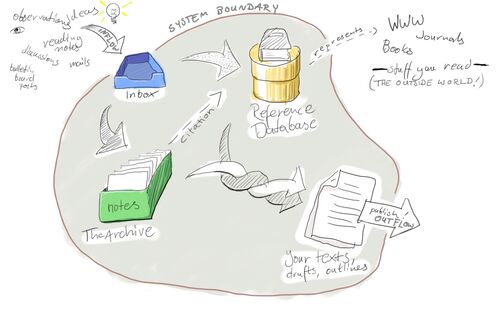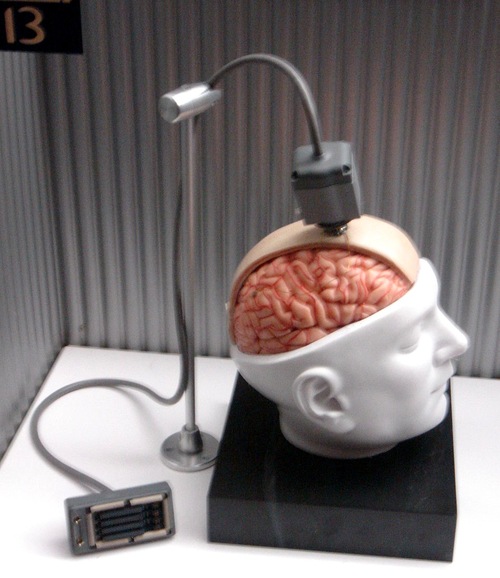Posts tagged “connect”
Why the Single Note Matters

A while ago, I offered free feedback on individual notes to seven people. I did this to showcase the importance of putting effort into individual notes. The ability to write a good single note is one of the main pillars of the Zettelkasten Method. In fact, it is a skill that is universally needed and independent of the Zettelkasten Method.
Improved Translation of “Communications with Zettelkastens”

Disclaimer: The original article by Luhmann is charged with his unique concepts that he developed for his social systems theory and a laconic German that is typical to the north of Germany. This is a strange challenge for any translator since you want to be faithful to the original, but at the same time there is a need similar to transposition in music: Transposition means that you lift everything up a pitch. I’d like to show you a translation of a paragraph that highlights the issue of translation itself:
How Value is Created in a Zettelkasten (and Any System of Knowledge Work)

The first question we need to ask ourselves is: What is value? I propose a simple answer to this question: Valuable is what is useful to us. Let’s look into knowledge on nutrition as an example: Knowing how to eat healthy is not very useful to a lot of people because this knowledge is not put into practice. Most of the time this knowledge is not what is needed. Eating healthy is rather about building habits. Then again, knowledge on healthy nutrition becomes useful when those healthy habits are built.
Using Cartography as a Metaphor for Investigating the Great Folgezettel Debate

Today, we’ve got a post by Austin Ha (@iamaustinha on the forum and on Twitter) that tackles the Folgezettel–vs–links-only debate from a different perspective – cartography! Austin went really far in preparing example archives to illustrate everything (download link at the bottom) so thank a lot for all this work!
No, I Do Not Underestimate the Power of the Dark Folgezettel – I Embrace Its Source of Power

A long time ago, Daniel wrote a reply to my reply to his article. This might be the spark that ignited the Great Folgezettel Debate. Daniel wrote that Luhmann didn't just create a network that looked like a interconnected web, but instead, he created something resembling an ordered tree.
RE: Backlinks Should Be Context-Rich

Jared Gorski wrote a response to my article “Backlinks are bad links”. Since it’s a short and concise response, a re-response is warranted. He summarised my point fairly and sufficiently, so I don’t need to repeat myself here. If you are not familiar, please read the article linked above. I’ll reply to Jared’s post point by point.
Backlinking Is Not Very Useful -- Often Even Harmful

Disclaimer: I talked with Christian about what backlinks are. I don’t mean it as a technical concept like software and web developers would use the term. To me, a backlink is a link that allows you to go to files that refer to the very note you are looking at. Practically, it does not matter how the backlink is generated, by hand or presented to you by your software. Automatic backlinks are not only automatic when there is software that is showing them for you. If you create a backlink apparatus by habit it is still automatic. The automatization software would then be in your head.
Emulate Automatic Link Suggestions in Your Note-Taking App and The Archive
If your note-taking app of choice doesn’t support auto-completion to suggest links while you type, what can you do? Not all software can implement the exact same feature that I’d like it to have. Then I try to figure out ways to use a tool to do what I want, breaking down the feature into more basic steps, each of which I could do manually, if needed. This works surprisingly well most of the time.
The Zettelkasten as a Lattice of Thought Strings

Please welcome Gerrit Scholle, aka gescho from the forums! Gerrit kindly took the time to write up his recent thoughts as a self-contained blog post, with colored pencil drawings and all! Enjoy. A recent forum post led me to an idea that seemed to be brewing in my subconscious for a little while.
Reader Question: Why Not Use a Plain-Text Wiki?
Sujith Abraham asks on YouTube: Why did you choose nvALT, where you have to create manual links so that you can search and find which other notes ‘backlinks’ to other notes, instead of a wiki (like DokuWiki, Tiddlywiki) where this would be provided automatically along with the benefit of plain-text writing/storage.
The Money Is in the Hubs: Johannes Schmidt on Luhmann’s Zettelkasten
Johannes Schmidt gave an awesome lecture but most of you don’t understand German. So I thought I’d give you a quick flash of my notes of some points that I found most important. Keep in mind that this is not a comprehensive overview. Some points are left out or presented with the intention to be more relevant but as a result can be biased.
Different Kinds of Ties Between Notes

After the awesome discussion of Sascha’s latest blog post, I meditated about all the different kinds of ties between notes. Here’s what I came up with. When you work with paper, it’s obvious that they have an order – but even digital note archives will put all your notes in some kind of order in the user interface to present them. This is done most likely as a list.
Building Blocks of a Zettelkasten

I am working hard on the “Building Blocks” chapter of the Zettelkasten book and I want to finish it first to show it to the public. It covers all parts of the toolkit. To sketch a structure and talk about its components, I need to get the requirements and implementation done before talking about workflow details. Today, I want to show you a birds-eye view of the overarching systems metaphor I’m using in the book.
Learn Faster by Writing Zettel Notes

As a knowledge worker, you have to learn a lot in your field. The internet is full of information, and there’s the books you just have to know in and out. How do you speed up the process and learn efficiently? Scott Young learned linear algebra in 10 days due to a very efficient method. It works for other fields of knowledge as well. The “Drilldown Method” consists of three stages:
Extend Your Mind and Memory With a Zettelkasten

A Zettelkasten is a device to extend your mind and memory so you can work with texts efficiently and never forget things again. Both permanent storage and interconnectedness are necessary to use the full potential of an archive for your notes. You need a permanent storage for your notes so they can give a cue for the things you want to remember. You also need to manually connect notes to create a web of notes which adjusts to the way your mind works.
Create a Zettelkasten for your Notes to Improve Thinking and Writing
Assuming you’re a writer or a thinker, why should you care about the way you take notes? If you want to think creatively and write original articles and books, you need to form associations in your mind effectively. Notes can help you with that if you adhere to a few basic principles. You can emulate communication processes with your own notes if you structure them in a certain manner. Notes can and should stimulate new associations and foster your creativity just like a good talk does.